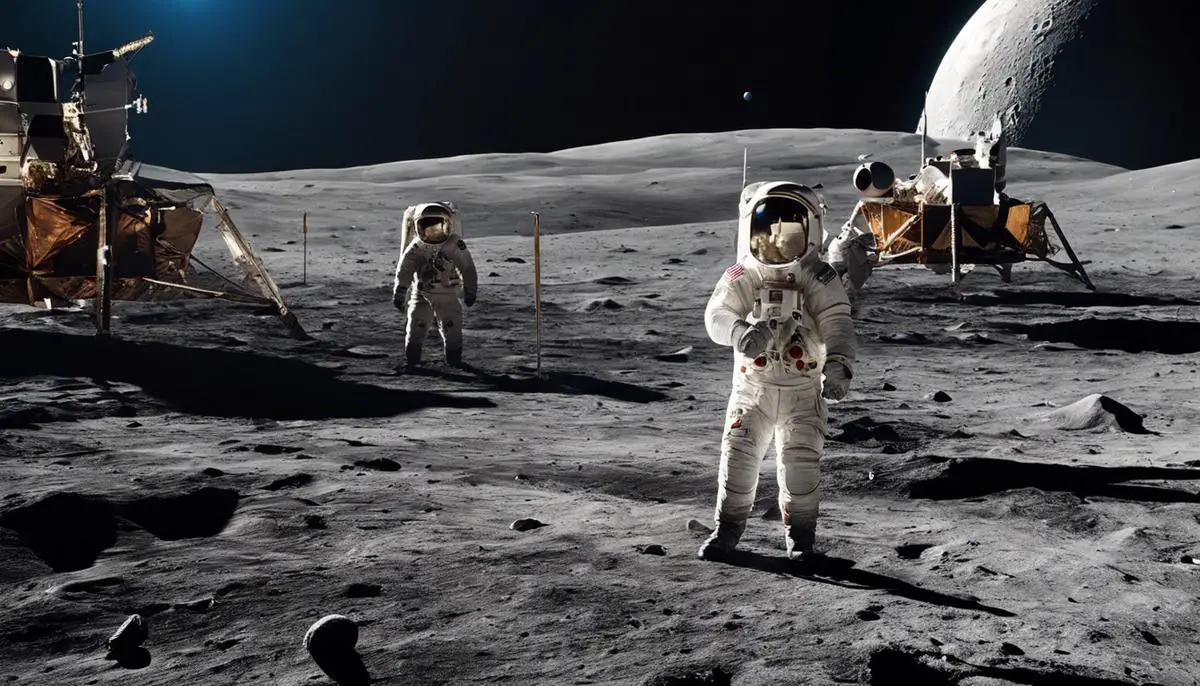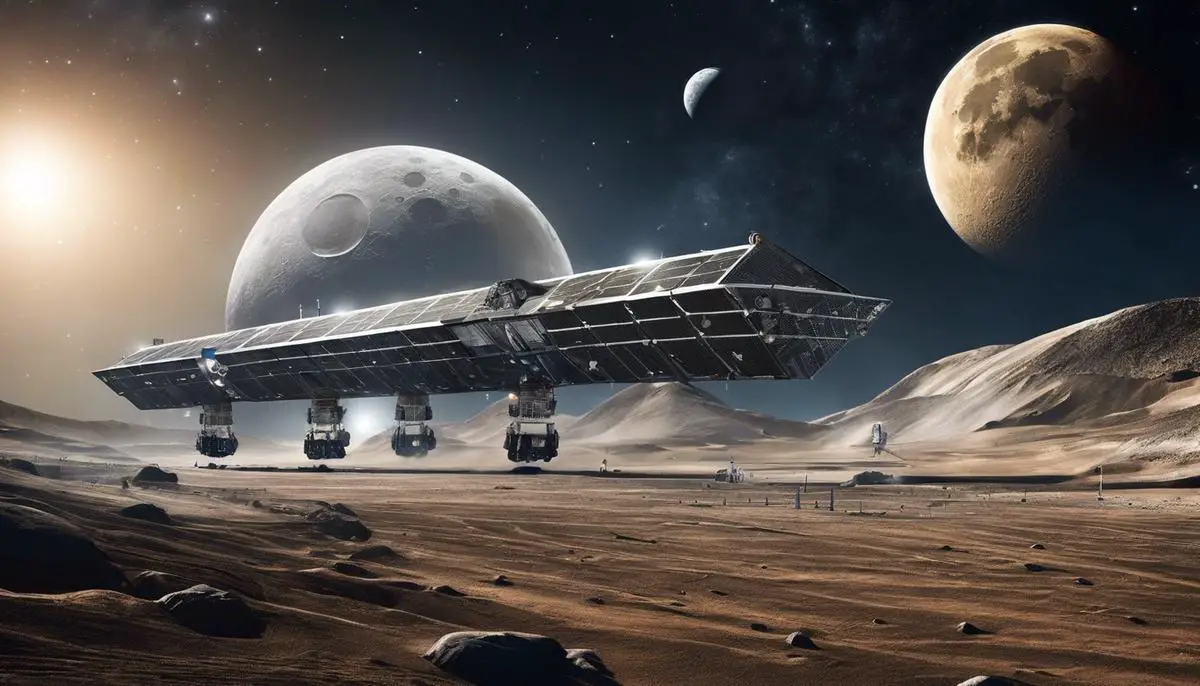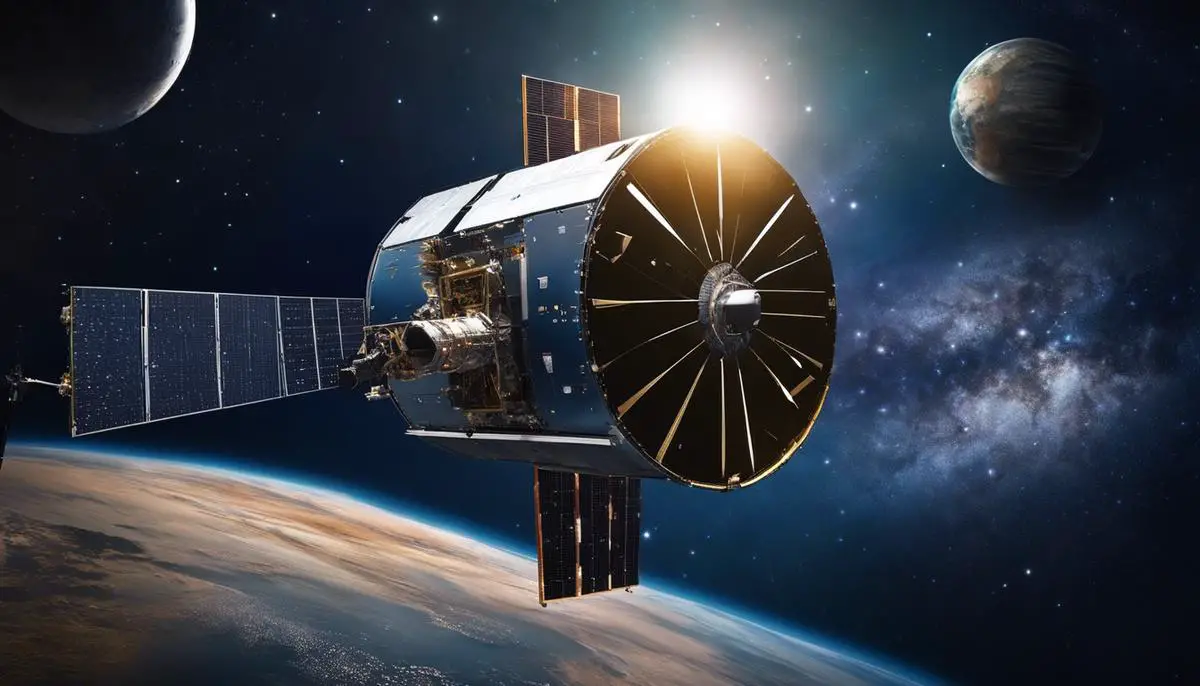As humanity casts its gaze once again towards the silvery orb that lights our night skies, NASA’s Artemis Program emerges as a beacon of exploration and progress. This ambitious endeavor marks a pivotal chapter in our extraterrestrial narrative, seeking to deliver the first woman and the next man to the lunar surface by 2024. It aims to transcend the bounds of Apollo, etching a sustainable human presence upon the Moon—a foundational step in our eventual stride towards Mars. Here, we unravel the tapestry of objectives, milestones, and key contributors that compose NASA’s lunar ambitions, weaving a comprehensive portrait of a mission poised to redefine our celestial aspirations.
The Artemis Program
Unlocking the Moon’s Potential: The Artemis Program’s Objectives and Timeline
In the spirit of pioneering exploration, the Artemis Program signals a new era of lunar discovery, backed by NASA and a coalition of international and commercial partners. With a vision that stretches beyond mere footprints and flag-planting, Artemis stands as a beacon of 21st-century space exploration, promising advancements that could reshape our relationship with the cosmos.
Objectives: Broad Horizons Beyond the First Step
The Artemis Program isn’t just about returning humans to the Moon; it’s about sustaining our presence there. A bold objective is the establishment of the first lunar base, a platform for deep-space exploration and a stepping stone for the ultimate journey to Mars. Scientific discoveries await as we probe the Moon’s South Pole, an area unvisited by previous missions and rich with potential resources, like water ice which could be converted into rocket fuel.
Another key objective is inclusivity. Artemis champions diversity, aiming to land the first woman and the next man on the lunar surface, symbolizing a future where space exploration is a domain accessible to all of humanity.
Innovation will thrive. Artemis calls for the development of cutting-edge technologies and spacecraft, from the powerful Space Launch System (SLS) rocket to the versatile Orion spacecraft and the lunar Gateway – an orbiting outpost designed to serve as a multipurpose hub for missions to and from the lunar surface.
Timeline: Stages of a New Lunar Legacy
The timeline for Artemis unfolds in deliberate, strategic phases. Artemis I, an uncrewed mission, sets the stage as a tangible proof of concept. Slated for the coming year, it will test the full might of the SLS and the resilience of Orion over an approximately three-week mission looping around the Moon.
Next, Artemis II will carry a crew on a similar path around the Moon, paving the way for subsequent landings. This mission, forecasted for the mid-2020s, will serve as a critical testbed for the systems and protocols that will govern future lunar missions.
The spotlight then shifts to Artemis III, the momentous mission that will see astronauts touch down on the Moon’s South Pole. Scheduled before the decade’s end, this ambitious project will herald a new chapter in space exploration and international collaboration.
Beyond these initial ventures, the Artemis Base Camp emerges as a cornerstone for sustainable lunar exploration and research. A lunar Terrain Vehicle (LTV), habitable mobility platform, and foundation surface habitat are all in the cards, setting the stage for a long-term human presence on the Moon.
The Vision: A Stratagem for the Future
The Artemis Program is more than a quest for knowledge; it’s a strategy for future-proofing humanity’s advances in space. By nurturing partnerships and catalyzing economic growth in a burgeoning space economy, Artemis stands as an exemplar of forward-thinking policy.
This program reinforces a commitment to safety, innovative partnership models, and a desire to inspire the next generation of explorers. We gaze upon the approaching lunar dawn, where multi-month expeditions on the Moon’s surface become a reality, each forging a path for the astronauts who will one day leave their boot prints on Mars.
Get ready to witness how Artemis reshapes our celestial ambitions, our technological horizons, and our place in the wider universe. As the Moon beckons with its silent allure, it’s clear that our future among the stars is just on the horizon. And with that, the stage is set – for discovery, for growth, and for a legacy that will echo through the annals of cosmic history.

Economic Implications
Revving up the Global Economy: The Moon as the Next Business Frontier
Picture this: job openings for lunar technicians. Logistics companies setting up shop not just globally, but extra-terrestrially. The prospect of the Moon’s missions are not confined to leaps for mankind or giant bounds for future astronauts; they’re effectively firing up engines of a nascent lunar economy, driving innovation, and potentially shifting the global economy’s trajectory.
Space, the final economic frontier, has long been dominated by governments. Yet, enter the era of lunar exploration, where private corporations are not just spectators but active participants. It’s no longer just about flag-planting; it’s about mining, manufacturing, and market creation.
Mining the Moon: More than Moon Rocks
The lunar surface is abundant in resources, notably Helium-3, a potential fuel for future nuclear fusion reactors. It’s cleaner, safer, and far more potent than the nuclear fission fuel currently powering our energy grids. Imagine the economic impact: countries vying for a cleaner energy source, a whole new market unfurling, complete with jobs, infrastructure, and legislation.
Then there’s water ice, a resource poised to revolutionize space travel by providing hydrogen and oxygen—key ingredients for rocket fuel and life support systems. This could give rise to ‘gas stations in space’, cutting down the cost of lofting weighty fuel from Earth. A complex economy could orbit around these moon-based fuel depots, expanding space travel, satellite maintenance, and beyond-Earth living possibilities.
Commercial Space Race: Catalyst for Tech Advancements
Commercial entities are indispensable to the Moon missions, invigorating economies through bleeding-edge technological advancements. GPS systems, advanced materials, and telecommunications have all benefitted from the space race, and the new lunar push is set to accelerate such developments. Companies at the frontier stand to reap first-mover advantages, securing intellectual property that could define future industries.
Global Space Supply Chain: An Intergalactic Silk Road
With lunar missions, a global space supply chain is inevitable, an intergalactic Silk Road with the Moon as a trading post. This will require a cadre of space-savvy legal professionals, policy makers, economists, and a new breed of supply chain managers. Countries and companies that invest in these supply chains can expect to shape—and dominate—the burgeoning space trade.
Satellite Service Industry: Skyrocketing Demand
Satellite launch and maintenance services are in for a boom, propelled by the Moon missions. An expected uptick in satellite-based internet, Earth observation, and space tourism necessitates a massive deployment and upkeep of satellite constellations. Another spin-off—a booming insurance industry for space assets. Groundbreaking, certainly, and lucrative without a doubt.
Down-to-Earth Impacts: Ground-based Industries Taking Flight
It’s not solely about space; ground-based industries are in for a spin. From boosting demand in advanced manufacturing and robotics to catapulting the educational sector into new orbits with a heightened emphasis on STEM, the repercussions are wide-reaching.
And It’s Not All Rocket Science
Notably, there’s room in space for creatives and marketers—to craft compelling narratives, brand the space experience, and make the celestial comprehensible and captivating for the masses. The arts, media, and entertainment will find new canvases among the stars, where storytelling will be thrust into another dimension—quite literally.
The Upshot: Economic Expansion Beyond Bounds
The Moon missions represent a turning point, sowing the seeds for an economic boom on Earth and beyond. The promise of space has always sparked imaginations, but now, it’s set to unleash economic potential that’s been hovering just beyond reach. The effects on global economies will be profound, reshaping industries, fostering international collaboration, and spinning off entirely new markets.
Excited? The Moon awaits, not as a distant luminary, but as the springboard for the next great economic epoch. Businesses, buckle up; the countdown to an interstellar industrial revolution has just begun. No need for a summary, the message is clear: the stars are aligning for an economic supernova, and the Moon is where it all takes off.

Technological Innovations
Seizing the Lunar Frontier: Breakthrough Technologies Powering NASA’s Moon Quest
Advancing a new era of lunar exploration, NASA’s Artemis program is not only a testament to human ambition but also a showcase of technological prowess. The mission isn’t simply about footprints and flags; it’s about fortifying a sustainable human presence, a feat that hinges on pioneering technologies. Let’s dive into the breakthroughs defining this monumental endeavor.
Harnessing Local Resources: In-Situ Resource Utilization (ISRU)
Beyond the bootprints, Artemis intends to unlock the Moon’s bounty, utilizing the materials found on the lunar surface while slashing dependency on Earth deliveries. ISRU is the cornerstone tech, primed to exploit resources like regolith (lunar soil) and sub-surface water ice. By transforming these raw materials into life-sustaining oxygen, water, and even building materials for habitats and tools, ISRU is pivotal for a self-sufficient lunar stay.
Rocketing Forward: The Space Launch System (SLS)
The towering Space Launch System is the backbone of Artemis, flaunting unprecedented power—it’s the most potent rocket to ever grace the skies. Boasting boosters that outmuscle any predecessors, SLS is engineered to catapult astronauts and gear beyond Earth’s grasp, aiming for deep-space exploits. This leviathan is the driving force, propelling humanity towards a sustained lunar future.
Human and Lunar Harmony: The Orion Spacecraft
The quintessence of human ingenuity, Orion is a celestial chariot designed for the long haul, safeguarding astronauts amidst the extremes of space. With state-of-the-art life support, fail-safe systems, and a robust shield against cosmic radiation, Orion is like a trailblazer’s cocoon, vital for bridging the gulf between Earth and the Moon.
Revolutionary Rovers: Lunar Terrain Vehicles (LTVs)
Conquering the lunar frontier demands more than just treading softly on the surface; it necessitates robust rovers ready to roam the unpredictable terrain. LTVs are envisaged as the go-to wheels for Artemis explorers, crucial for carting astronauts across vast lunar expanses. These rover innovations promise extended range, carrying capacity, and adaptability to the Moon’s rugged landscapes.
Lunar Habitats and Outposts
Constructing a home away from Earth is no small feat, and Artemis is rising to the challenge with lunar habitats—modern marvels teeming with advanced robotics and automation. These habitats, potentially inflatable or 3D-printed using ISRU-derived materials, aim to offer astronauts a slice of Earthly comfort while weathering the Moon’s unforgiving environment.
Robotic Scouts: Paving the Path
Proving that exploration isn’t a human-exclusive venture, robotic partners are set to play a pivotal role in Artemis. These pre-deployment scouts will chart the terrain, identify valuable resources, and prep the lunar landscape for human arrivals. Their contribution—a blend of reconnaissance and groundwork—is invaluable for the success of the Artemis missions.
Enhanced Communication Networks: The Lunar Gateway
Visualize a multipurpose portal orbiting the Moon: The Lunar Gateway, part command center, part docking station. This critical infrastructure is a springboard, streamlining communication and transport between Earth, Moon, and beyond, also serving as a temporary abode for astronauts. Envisioned to augment and sustain lunar enterprises, the Gateway is the lynchpin in this celestial web.
Artificial Intelligence and Automation: Smart Exploration
A symphony of artificial intelligence (AI) and automation tech are set to transform lunar exploration. Smart systems are envisioned to oversee habitat functions, LTVs, and even scientific experiments autonomously—maximizing efficiency while minimizing human risk. AI capacitates the Artemis vision, from crunching colossal data to averting mission-critical anomalies.
Drawing upon the zeal that forged a path to the Moon, Artemis is poised to recreate history—incubating a hatchery of celestial ambitions. Each leap of innovation echoes the overarching goal: securing humanity’s foothold in the void and catalyzing an interstellar paradigm.
The lunar dreamscape, once a myth, is being etched into reality by these transformative technologies—gearing us for a future where the Moon is not a destination but a beginning.

Astronaut Selection and Training
Embarking on Humanity’s Next Frontier: The Rigorous Journey to Become an Astronaut
As humanity gazes upward, the allure of space exploration calls forth the bravest and best among us—astronauts. These modern-day explorers embark on a journey that transcends mere fascination; it is an odyssey wrought with grueling preparation and steadfast commitment.
The astronaut selection process is not a stroll in the park—it’s an Everest climb, metaphorically speaking. Dreamers with stars in their eyes must first ground themselves in reality because astronaut candidates are chosen based on a matrix of highly technical qualifications and exceptional personal attributes.
To don the prestigious title of an astronaut, individuals need extensive knowledge and expertise in fields such as engineering, biological science, physical science, computer science, or mathematics. But an imposing resume is just the launch pad. Potential astronauts must stand out through leadership skills, team dynamics, and a character that thrives in high-pressure environments. The process is intensely competitive, with thousands of applicants vying for a spot in the stars, but only a star-studded few make the cut.
Once selected, astronaut trainees gear up for an intense training regimen that could humbly be described as ‘comprehensive’. This phase is a behind-the-scenes epic, as candidates are immersed in a curriculum that feels like it’s straight out of a sci-fi novella. Spacewalks in large swimming pools—known as Neutral Buoyancy Labs—simulate zero-gravity, serving as practice grounds for the real deal. Fitness training ensures they can endure physical demands of space missions, while survival training prepares them for any possibility, even crash landings on Earth.
They master operating spacecraft built upon cutting-edge technology, learning the intricacies of the Space Launch System (SLS), the Orion spacecraft, and future Lunar Terrain Vehicles (LTVs). The development of lunar habitats and exploration of robotic scouts are also in their domain, equipped with an understanding of Artificial Intelligence (AI) and automation to assist them on their pioneering quests.
And as we hone our sights on a sustainable lunar presence with the Artemis program’s grand ambitions, the need for astronaut expertise expands further.
In-Situ Resource Utilization (ISRU) techniques are a pillar of autonomy for lunar explorers, turning the harsh moon environment into a springboard of opportunity. Harnessing the Moon’s resources will require knowledge in the novel field of extraterrestrial mining and processing—a stark departure from traditional Earth-centric systems.
Transitioning from gravity-bound to celestial voyagers also involves acclimating to the peculiarities of life in a habitat on the lunar surface. Aspirants face training that familiarizes them with living quarters, workspaces, and support infrastructure designed for the rigors of space living.
Not to mention the psychological mettle required—one must be able to maintain composure and high cognitive function when faced with the solitude and confinement space travel often entails.
The candidate’s proficiency with Lunar Gateway operations is crucial, as this outpost will serve as a multi-purpose hub orbiting the Moon, carving the path for further deep space exploration.
But the journey isn’t just about the individuals taking flight; it has a ripple effect that inspires countless others. As we push into the unknown, we inspire future innovators to dream bigger, work harder, and aim higher.
Embracing the adventure of astronaut training is to accept a role in the larger narrative of interstellar discovery. It’s a blazing testament to human endurance, capability, and insatiable curiosity. As we stand on the cusp of redefining what it means to explore, those who rise to become astronauts will not only change their lives but potentially the course of human history.

Photo by wesleyphotography on Unsplash
Business Opportunities
Unlocking New Economic Frontiers: Business Prospects in the Post-Artemis Era
As NASA’s Artemis missions carve a new path for lunar exploration, a treasure trove of business opportunities beckons for savvy entrepreneurs and established industries alike. With the celestial curtain rising, let’s spotlight the business ventures that are set to flourish in this new space age.
Mining operations on the Moon aren’t just the stuff of science fiction. As lunar exploration uncovers Helium-3 and water ice deposits, enterprising firms are already laying plans to harness these resources. Water ice, essential for sustaining life and fuel production, may turn the Moon into a refueling station for deeper space voyages, turning space entrepreneurs’ gazes towards the lunar surface with dollar signs in their eyes.
The commercial space race is red-hot. Companies that have until now watched from the sidelines are advancing towards the forefront, determined not to miss out on the spoils. Intellectual property rights related to space travel tech are bound to be catalytic in securing a competitive edge. Patent attorneys, gear up—a new niche in cosmic-scale IP law is opening up.
Meanwhile, a global space supply chain is emerging. This isn’t just about launching rockets; it’s about intergalactic trading, logistics, and supply chain management that could well redefine MBA curriculums. From sourcing lunar regolith for construction to establishing off-Earth manufacture bases, an MBA in Moon Commerce doesn’t seem far-fetched anymore.
Let’s not forget the satellite service industry, which is anticipated to experience a boom. Demand for satellite launches will spike, but equally crucial will be the maintenance of these orbital sentinels. Space agencies and private sector partners alike should prepare to explore novel revenue streams in launch services, maintenance, and repair operations—this could be the new frontier for the aerospace gig economy.
Back on terra firma, the economic ripple effect is palpable. Ground-based industries such as advanced manufacturing, robotics, and AI will witness a renaissance, as innovations aimed for the stars find their applications on Earth. The line between aerospace and other industries is blurring, with cross-pollination fostering innovation at an unprecedented pace.
The Artemis era dawns with a call for creatives and marketers as well, because what’s a moonshot worth if no one knows about it? Branding the cosmos, crafting compelling narratives around lunar products, and engaging a global audience are roles just as critical as the engineers and scientists behind the tech. The space industry’s trajectory will need the magic touch of those who can transform technical achievements into stellar stories that capture imaginations.
In the wake of space exploration, there’s talk of In-Situ Resource Utilization—ISRU, in space speak. Future lunar bases might not just be living quarters, but hubs for harvesting and processing Moon materials on-site. Entrepreneurs with an eye for the circular economy could find fertile ground here.
From the Space Launch System to the Orion spacecraft, Lunar Terrain Vehicles to robotic scouts, each cog in the Artemis machine presents an opening. Consider Lunar Gateway’s pivotal role in orbital science and support; businesses that dive into operations and logistics coordination could become essential fixtures in the lunar landscape.
Last but not least, the astronaut corps remains at the heart of human spaceflight. A surge in staffing for space missions is on the horizon, with private companies joining the ranks to recruit and train the next wave of lunar explorers. From comprehensive simulations to mastering Lunar Gateway operations, this too cracks open a door for PMOs and training organizations to scale up their offerings and tailor them to the needs of this expanding sector.
It’s clear that the aftermath of the Artemis missions isn’t just a small step for a few industries; it’s a giant leap for global economic expansion. Whether providing the picks and shovels for a 21st-century space rush or laying the cornerstone of the first lunar marketplace, there’s much to be done—and gained. Space isn’t just the final frontier for exploration; it’s the new marketplace for the bold, the innovative, and the economically astute to carve their legacy in the cosmos.

The voyage to the Moon spearheaded by the Artemis Program is far more than a triumph of human spirit and curiosity; it is a cornerstone laying the infrastructure for a future intertwined with the cosmos. As we pivot our attention to the stars, we beckon a new era of economic prosperity, technological innovation, and boundless opportunities. The astronauts, rigorously chosen and painstakingly trained, will not only leave their footprints on the lunar dust but will also imprint a legacy of inspiration and expansion that will echo through industries and lives for generations to come, culminating in a shared odyssey that extends beyond the horizon of our blue planet.
![]()
